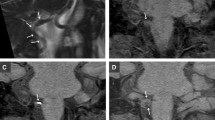Abstract
The purpose of this study was to evaluate the role of color Doppler sonography (CDS) in the diagnosis of extracranial vertebral artery dissections (EVADs). One hundred and fifty consecutive patients (age range 21–51 years, mean 44 years) with a clinical suspicion of vertebral artery dissection (VAD) were included in this study. All patients underwent CDS of vertebral arteries as the first-line imaging modality. Cervical T1-weighted fat-saturated axial MR images served as the gold standard. Of the 150 patients with a clinical suspicion of VAD, 27 patients were ultimately diagnosed with EVADs based on fat-saturated T1-weighted MR imaging. MR imaging was considered positive when crescentic hyperintensity (methemoglobin signal) was demonstrated at the wall of the vertebral artery. CDS was positive in 21 of these 27 patients and revealed either intramural hematoma or a dissecting membrane with two lumina. The most frequent site of involvement was the V1 to proximal V2 segment. The sensitivity, specificity, and positive and negative predictive values of CDS in the diagnosis of EVADs were 77.8, 98.4, 91.3, and 95.3%, respectively. CDS is a reliable diagnostic tool in the diagnosis of EVADs.



Similar content being viewed by others
References
Gottesman RF, Sharma P, Robinson KA, et al. Clinical characteristics of symptomatic vertebral artery dissection. A Systematic Review. Neurologist. 2012;18:245–54.
Vertinsky AT, Schwartz NE, Fischbein NJ, et al. Comparasion of multidetector CT angiography and MR imaging of cervical artery dissection. Am J Neuroradiol. 2008;29:1753–60.
Lu JC, Sun Y, Jeng JS, et al. Imaging in the diagnosis and follow-up evaluation of vertebral artery dissection. J Ultrasound Med. 2000;19:263–70.
Bartels E, Flügel KA. Evaluation of extracranial vertebral artery dissection with duplex color-flow imaging. Stroke. 1996;27:290–5.
Yang L, Ran H. Extracranial vertebral artery dissection: findings and advantages of ultrasonography. Medicine (Baltimore). 2018;97:e0067.
Rodallec MH, Marteau V, Gerber S, et al. Craniocervical arterial dissection: spectrum of imaging findings and differential diagnosis. RadioGraphics. 2008;28:1711–28.
Flis CM, Jäger HR, Sidhu PS. Carotid and vertebral artery dissections: clinical aspects, imaging features and endovascular treatment. Eur Radiol. 2007;17:820–34.
Pugliese F, Crusco F, Cardaioli G, et al. CT ahgiography versus colour-Doppler US in acute dissection of the vertebral artery. Radiol. Med. 2007;112:435–43.
Wessels T, Mosso M, Krings T, et al. Extracranial and intracranial vertebral artery dissection: long term clinical and duplex sonographic follow-up. J Clin Ultrasound. 2008;36:472–9.
Gottesman RF, Sharma P, Robinson KA, et al. Imaging characteristics of symptomatic vertebral artery dissection. Neurologist. 2012;18:255–60.
Siepmann T, Borchert M, Barlinn K. Vertebral artery dissection with compelling evidence on duplex ultrasound presenting only with neck pain. Neuropsychiatr Dis Treat. 2016;1:2839–41.
Gottesman RF, Sharma P, Robinson KA, et al. Imaging characteristics of symptomatic vertebral artery dissection. Neurologist. 2012;18:255–60.
Provenzale JM. MRI and MRA for evaluation of dissection of craniocerebral arteries: lessons from the medical literature. Emerg Radiol. 2009;16:185–93.
Siepmann T, Borchert M, Barlinn K. Vertebral artery dissection with compelling evidence on duplex ultrasound presenting only with neck pain. Neuropsychiatr Dis Treat. 2016;1:2839–41.
Author information
Authors and Affiliations
Corresponding author
Ethics declarations
Conflict of interest
The authors declare that they have no competing interests or sources of funding.
Ethical statement
All procedures followed were in accordance with the ethical standards of the responsible committee on human experimentation (institutional and national) and with the Helsinki Declaration of 1975, as revised in 2008.
Informed consent
Informed consent was obtained from patients for being included in the study.
About this article
Cite this article
Yılmaz, C., Gorgulu, F.F., Oksuzler, F.Y. et al. Color Doppler ultrasonography is a reliable diagnostic tool in the diagnosis of extracranial vertebral artery dissections. J Med Ultrasonics 46, 153–158 (2019). https://doi.org/10.1007/s10396-018-0901-2
Received:
Accepted:
Published:
Issue Date:
DOI: https://doi.org/10.1007/s10396-018-0901-2




